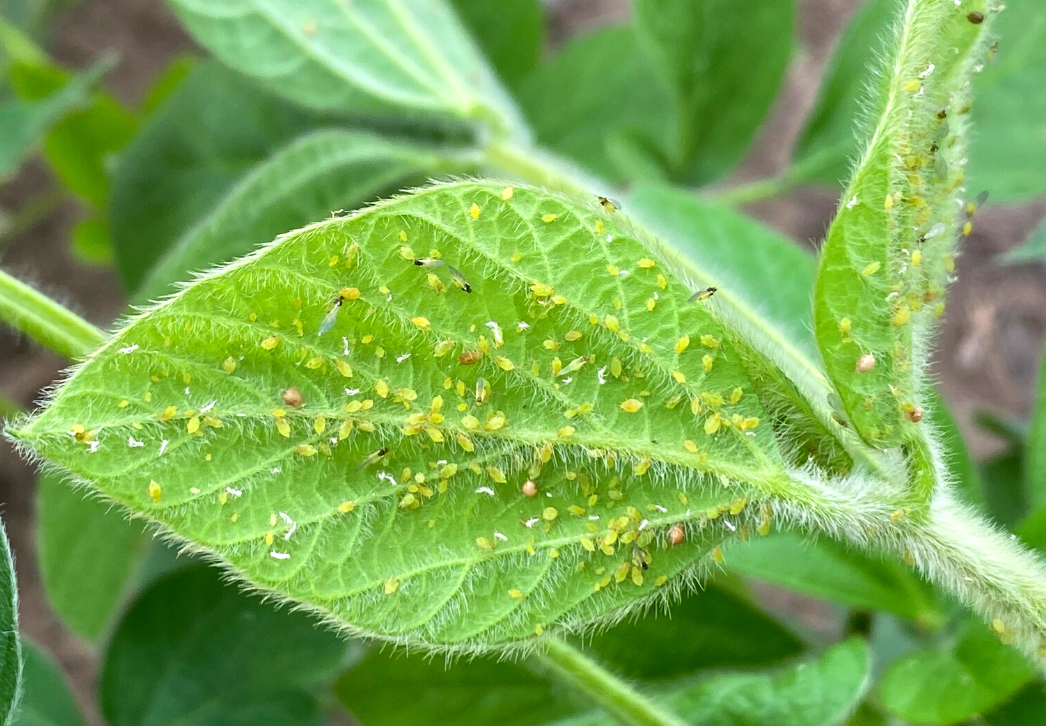|
|
Sweltering weather prevailed across Wisconsin and much of the US this week, as a summer heat wave left over 100 million people in more than a dozen states under excessive heat advisories and warnings. Daytime highs across Wisconsin soared to the mid-90s, with even far northern locations from Ashland to Peshtigo reporting temperatures of 90-94 degrees Fahrenheit on July 19. The heat was accompanied by scattered showers that provided some relief for crops, growers and DATCP staff working in the field.
Survey activities for the week ending July 21 included scouting for mid-season corn and soybean pests, and monitoring western bean cutworm and corn earworm traps. In addition, the spongy moth (formerly gypsy moth) outbreak that has plagued southern Wisconsin this month finally began to subside as caterpillar populations enter the non-feeding pupal stage.
__________________________________
  Soybean aphids and parasitoids | K. Hamilton DATCP
 
|
|
The annual soybean aphid survey now underway suggests populations are still generally low. All but two of the 79 soybean fields (R2-R3) sampled July 11-20 had field-wide average counts of less than 25 aphids per plant. The two exceptions were in Buffalo and Rock counties, where averages of 55 and 59 aphids per plant were recorded. Individual plants in the margins of these fields were infested with up to 500 aphids, although beneficial lady beetle larvae and parasitic wasps were also very active at these sites (see photo above).
Soybean aphid pressure is expected to intensify by early August and control may be warranted for some fields. Soybean producers and crop advisors are reminded that insecticide treatment is not necessary until the threshold of 250 aphids per plant on 80% of the plants throughout the field has been exceeded. Treatment of this pest, if required, is most advantageous when applied during the R2-R4 (full bloom to full pod) stages.
In addition to aphids, Japanese beetles are also becoming more abundant in Wisconsin soybean fields. Recent surveys found beetles in 91% (72 of 79) of the sites sampled, with two of 79 fields showing above-threshold levels of defoliation. The economic threshold for Japanese beetle and other leaf feeding soybean pests is 20% defoliation between the bloom and pod fill growth stages. When estimating defoliation, it is important to examine the entire plant by selecting a trifoliate from the upper, middle and lower canopy of 10 plants, for a sample size of 30 trifoliate leaves. It is also critical to obtain a representative sample from several spots across the field since the heaviest feeding injury is most often concentrated along the edges. |
|
 __________________________________
|
|
|
Japanese beetles on corn | K. Hamilton DATCP
 
|
|
|
Western bean cutworm activity increased sharply this week with the capture of 761 moths in 36 pheromone traps. The cumulative state count to date is 945 moths, which is significantly lower than 1,555 moths in 48 traps at the same time last year. The highest count for the July 14-21 monitoring period was 117 moths in the trap near Portage in Columbia County.
Based on the degree day model for this insect, 25% of the annual flight should occur across southern Wisconsin in the week ahead. This event coincides with the accumulation of 2,577 degree days (modified base 38°F). Scouting for western bean cutworm larvae and egg masses is most critical next week, especially in corn fields expected to reach 90-95% tassel emergence.
Corn earworm migration flights were registered for the second week. DATCP’s network of pheromone traps captured 30 moths July 14-21, with counts recorded at four of the 13 sites. The high individual trap count of 21 moths was reported from Mayville in Dodge County. The increase in moth captures signals that scouting of silking sweet corn is in order. Protective treatment of sweet corn fields with green silks is recommended once pheromone traps begin registering 5-10 moths per night for three consecutive nights. Corn earworm trapping network participants are reminded to replace lures on a weekly basis.
Light to moderate infestations of 1-32 Japanese beetles per 100 plants have been observed since early July in Wisconsin corn. The greatest threat to fields at this time of year is when large numbers of beetles converge and feed on the silks, potentially impairing pollination. It is especially important to scout for silk clipping during the first five days of silking. As is the case with soybeans, Japanese beetles show an edge effect in corn and obtaining a representative field-wide sample is required before making control decisions. A foliar insecticide is warranted if all three of the following conditions are met:
- Three or more beetles are present per ear
- Silks have been clipped to less than ½ inch
- Pollination is less than 50% complete
Spot treatment may be sufficient if damage is confined to the edge area. As a reminder, scouting should continue until pollination is complete since Japanese beetles are highly mobile and can continue to reinfest fields even after an insecticide application.
|
|
 __________________________________
|
|
Defoliation from spongy moth has been prevalent this summer in southeast and south-central Wisconsin, with numerous reports coming from Dane, Iowa, Jefferson, Kenosha, Racine, Sauk, Walworth, and Waukesha counties. According to DNR Invasive Insects Coordinator Andrea Diss-Torrance, populations have been in an outbreak phase due to impact of last year’s hot, dry weather on natural enemies. Trees can withstand two and even three successive years of defoliation before the risk of tree death substantially increases. Healthy trees are typically able to produce a second flush of leaves later in the summer.
Spongy moth feeding damage will be drawing to an end as caterpillars pupate and moth flight begins across the state. As of July 21, phenological models predict that 50% or more of the larval population has pupated across the southern two-thirds of Wisconsin. Male moth flight has started, with confirmation via trapping and field reports coming from most counties throughout the southern half of the state. |
|
 __________________________________
|
|
|
|